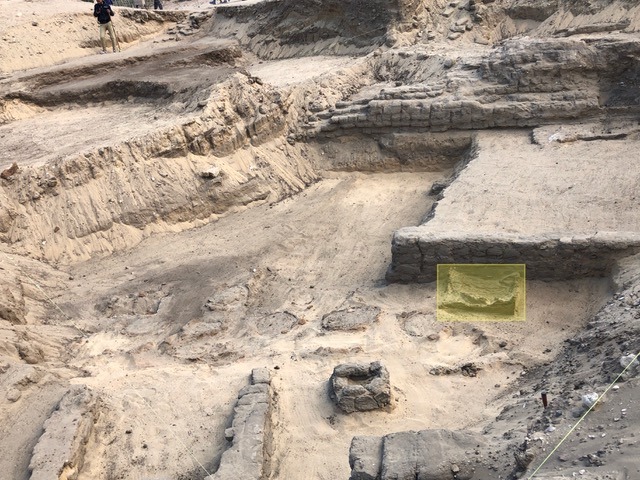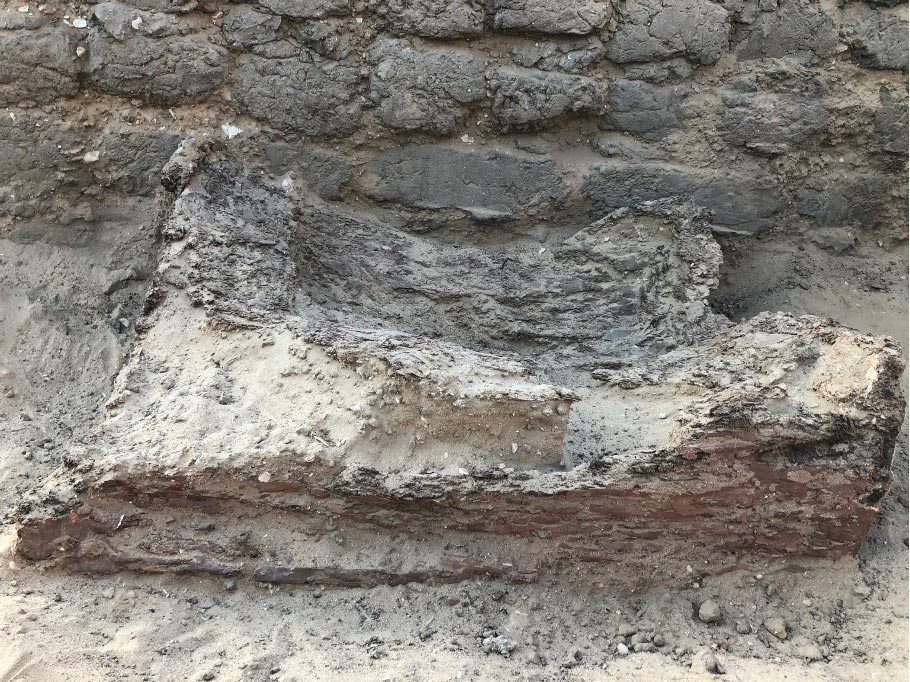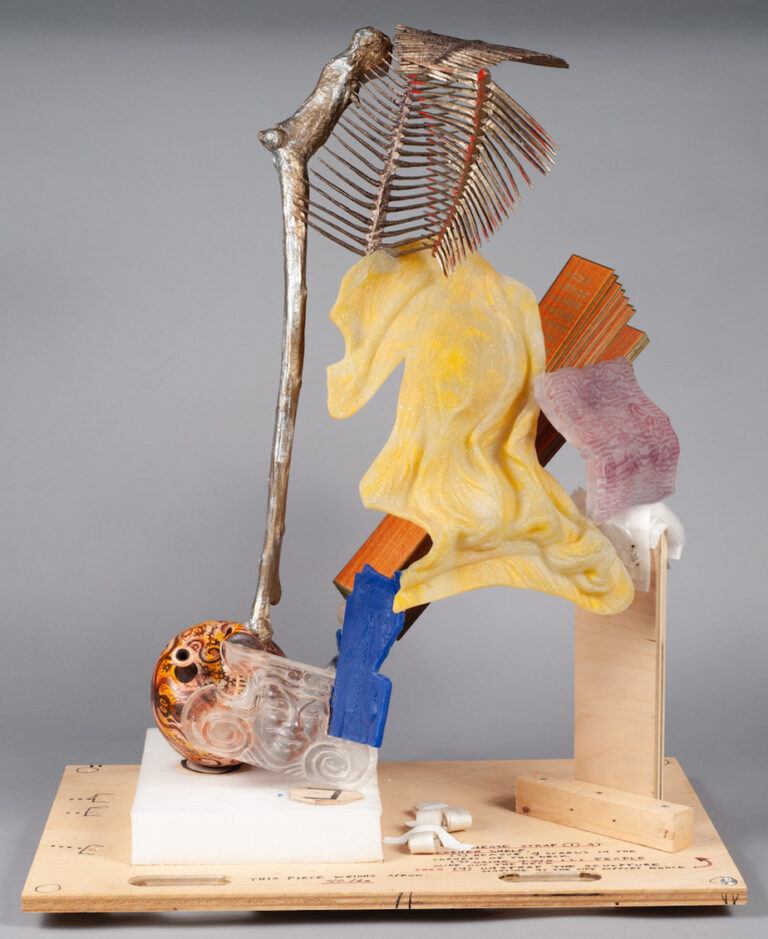Your browser is out-of-date!
Update your browser to view this website correctly. Update my browser now
Discovering Affinities between Ancient & Contemporary Cultural Heritage Conservation
by Sarah Montonchaikul, 2019-2020 Dedalus Fellow in Conservation

Fig 2. View of the excavation area with the child’s coffin highlighted in yellow. Photo: Sarah Montonchaikul, North Abydos Expedition
If an artwork does not exist physically, how can it be accurately documented and monitored?
Conservators of modern and contemporary artworks face a range of challenges from treating works done in unorthodox materials, such as polyurethane plastics, to seemingly non-material performance works that exist only fleetingly in real time. Their responsibility to preserve and maintain objects that resist traditional art historical and conservation taxonomies, however, has shaped the development of art conservation theory beyond modern and contemporary art and has inspired me to critically examine how we approach the preservation of cultural heritage today.
The conservation of modern and contemporary art is often complicated by the need to mediate the tension between the intangible or conceptual aspects of a work and its tangible counterparts. The physical deterioration and material changes undergone by an artwork over time are familiar, even expected, phenomena that must be carefully recorded in the course of designing a conservation treatment. At the same time, conservators must also record the above-mentioned intangible and conceptual aspects of a work that are not so easily captured via the usual documentation modes, i.e., photography and other imaging techniques. Some questions naturally follow: if an artwork does not exist physically, how can it be accurately documented and monitored? If a performance piece, which performance is the original or authentic one?[1]
In order to arrive at a course of treatment that is comprehensive and appropriate, modern and contemporary art conservators need to go beyond the checklist of material changes. But are they alone in this respect?
It is not just modern and contemporary art conservators who encounter objects that demand an investigation of both their material and immaterial elements. My experience as a Dedalus Foundation Fellow and a student working on an archaeological excavation, prompted me to reflect upon the affinities that exist with the complex notion of authenticity and adequate documentation.
I have treated a variety of works during my education and training as an objects conservator, spanning objects from Egypt’s Old Kingdom period (ca. 2649–2130 B.C.E.) to Angel: The Shoe Shiner, a sculpture made by Pepón Osorio in 1993.[2] My art historical interests are similarly broad. With this background, I found myself drawn to an active discussion in conservation scholarship: can comparisons be made between the value systems that inform the treatment of archaeological objects and those espoused by modern and contemporary art conservators? A recent conservation treatment conducted on a site in Abydos, Egypt, pointed to some intriguing parallels between the decision-making processes of these seemingly disparate conservation specializations.
The North Abydos Expedition, jointly sponsored by NYU’s Institute of Fine Arts and Princeton University, began the 2020 season in February with excavations of a part of the ancient site known familiarly as “Peet’s Cemetery D.”[3] This section of the Abydos archaeological landscape has seen frequent, multi-purpose use over more than 3500 years, from the Early Dynastic through the Coptic Periods, with activities that ranged in scope from Early Dynastic breweries to Middle Kingdom funerary practice to Late Antique monastic dwellings.

Fig 1. Child’s wooden coffin, Middle Kingdom period. The coffin was in a state of extreme deterioration.
After several weeks of excavation, the archaeologists exposed a child’s wooden coffin dating from the Middle Kingdom period, ca. 1900 B.C.E. (fig. 1).
Object retrieval in an active excavation context raises issues of documentation and prioritization related to the value of an artifact’s tangible existence, the value of the intangible information it embodies, and the methods by which archaeologists and conservators collaboratively work towards research goals of excavation. This case study of the child’s coffin prompted an examination of the relationship between the object’s physical existence and its function as an artifact in the archaeological record relative to the research questions of the 2020 excavation season. The archaeologists working in Peet’s Cemetery D this season were investigating the Early Dynastic breweries and activities associated with beer production, whose extant remains lie beneath thousands of years of sand and soil accumulation. In the process of excavation, archaeologists recovered artifacts (finds) and architectural fragments from all periods of habitation and use before exposing the stratigraphic layers dating to the Early Dynastic. The child’s coffin––likely made and used during Dynasty 12, much later than the strata with the breweries––posed a significant challenge to both the conservation and excavation teams.
The coffin was in a state of extreme deterioration.
The walls and lid sustained severe insect damage and buckled inward, losing all structural integrity and allowing burial soil to fill the interior of the coffin. Upon closer examination, all of the damage appeared to have occurred post-interment, indicating that the burial remains found inside were likely undisturbed. The construction and decoration of the coffin were commensurate with a date of the 12th Dynasty and featured no distinguishing campaigns of ornament or significant departures from common woodworking methods of this period. As such, the coffin represented typical funerary furnishings of the Middle Kingdom, many examples of which were already in the storage depots at Abydos. The conservation team presented the observations made during our examination of the coffin in the field; most notably that a heroic effort would be needed to successfully recover the find due to its extreme vulnerability. Additionally, accessing the interior of the coffin to document the burial would require lifting fragments of the lid and clearing away all of the burial soil that had infiltrated over centuries. These tasks in turn would require several days of active conservation work, which would halt all excavation efforts in the sector. Access to the Early Dynastic material beneath the coffin would be delayed significantly in the midst of an already-abbreviated excavation timeline. Another important constraint was the time it would take to process, document, and recover the human remains in the coffin in a safe and conscientious manner.[1] This essential part of treatment could not be compromised.
[1] While the treatment of the human remains associated with this burial is outside the scope of this blogpost, it is important to note that the North Abydos Expedition bioarchaeologists recovered the remains after photographic documentation of their location in situ. Human remains are stored separately from artifacts in the North Abydos Expedition storage building and are not treated by the conservation team. However, conservators and bioarchaeologists at Abydos work together to design and implement appropriate housing materials for human remains.

Fig 2. View of the excavation area with the child’s coffin highlighted in yellow. Photo: Sarah Montonchaikul, North Abydos Expedition
A swift decision was necessary.
Given that the find presented very real obstacles to accessing evidence of ancient brewing activity present in the archaeological record below, that many coffins of this material and manufacture have been studied previously, and that recovering this one would require an enormous investment of time and materials (both of which are precious commodities onsite), it was decided that the coffin itself could not be salvaged and would in fact be destroyed in the process of excavating further. However, a careful record of it would first be made; and before this could occur, it had to be stabilized in situ for documentation. While all excavated objects that undergo conservation are photographed before and after treatment, special care was taken with the child’s coffin to photograph the intermediate steps of the consolidation and stabilization treatment of the exterior paint layers in detail. The consolidation did not alter the color or sheen of the paint significantly, but instead stabilized the object’s surface, allowing further removal – and further documentation – to take place. Details of the object’s physical nature and archaeological context were documented using narrative records in the form of excavator’s field notebooks and conservation treatment reports, high resolution photography at several different stages of removal, and GIS-point mapping of the coffin. A fragment of the coffin was retained in onsite storage, which could be used for instrumental analysis if future research was required.
Thus, the suite of documentation and the fragment of wood came to represent the “object” in place of the coffin’s actual, physical existence. While the decision not to preserve the material of the object may seem to run counter to the preservation objectives of art conservation, the role of documentation as a surrogate for an art object is not uncommon in the field of modern and contemporary art conservation. Pip Laurenson addresses this tension between the material and the immaterial, writing:
The conversation between the archaeologists and us, the conservators, will sound familiar to anyone who has participated in the documentation of a performance artwork. In the case of the child’s coffin, our course of treatment resulted from the ontological shift that was necessitated by the conditions of fieldwork. Rather than focusing on the material existence of the coffin, we prioritized its preservation through documentation. The sample retained in storage can provide useful insight into the materials used to create the coffin and scholars can refer to the object file with the treatment narrative and photography to study the object in an archaeological context. We can consider the documented coffin as a representation of itself, a different yet nonetheless informative mode of existence.
Documentation of performance works also fill this different but informative role. Consider the work of Brazilian Neo-Concrete artist Lygia Clark, who created wearable artworks that were meant to be performed. She said of her work: “What’s important is the act of doing, in the present.”[i] One such work, O eu e o tu (The I and the You), is a pair of electric blue suits worn by two participants which are connected by a cord attached to each abdomen.[ii] Clark saw her audience as living elements of sculpture from this period of her work. They inhabit the suits and move in them, activating the artwork and completing it. Photographic documentation of the performance provides key details that present a holistic understanding of the work beyond a technical examination of the extant suits. The industrial rubber, foam, vinyl, acrylon, zippers, water, and fabric should be preserved as essential components of The I and the You, but the record of the performative component of the work is a conservation activity that is just as essential. The photographs signal that the work is not contained only within the physical bounds of the suits nor within the image field of the photograph. They are records of what the completed artwork was, is, and should be in the future.
As Jonah Westerman posits, performance and documentation are inextricably linked. What that documentation is, precisely, is not fixed; performance and documentation are “dynamically co-determining.”[iii] The performance informs its documentation and vice versa. They coexist as essential elements forming the work. The coffin fragment as the vestige of its physical existence, the remains of the individual buried within it, and the suite of documentation produced are these essential elements, both necessary to understand the artifact as a whole.
My year as a Dedalus Foundation Fellow allowed me to synthesize these two seemingly disparate interests within the fields of art history and conservation. The malleability of the conservation theories has enriched my understanding of created objects of material culture, whether they were made millennia ago or just last year. By interrogating traditional frameworks of conservation and art historical investigation, we can devise conservation protocols that best serve the preservation needs of these complex artworks.
Citations
[1] For further discussion: Bek, Reinhard: Between Ephemeral and Material – Documentation and Preservation of Technology Based Works of Art; In: Scholte, Tatja; Glenn Wharton (ed); ‘Inside Installations – Theory and Practice in the Care of Complex Artworks, Amsterdam, 2011, p. 205 – 215; Laurenson, Pip: Authenticity, Change and Loss in the Conservation of Time-Based Media Installations, In: Tate Papers, Tate’s Online Research Journal, http://www.tate.org.uk/download/file/fid/7401
Phillips, Joanna. “Reporting Iterations: A Documentation Model for Time-Based Media Art.” In Performing Documentation, Revista de História da Arte, edited by Gunnar Heydenreich, Rita Macedo, and Lucia Matos, pp. 168–79. Lisbon: Instituto de Historia da Arte, 2015.
[1] https://whitney.org/collection/works/8419
[1] For more information, visit https://abydos.org/.
[1] Laurenson, Pip: Authenticity, Change and Loss in the Conservation of Time-Based Media Installations, In: Tate Papers, Tate’s Online Research Journal, http://www.tate.org.uk/download/file/fid/7401
[1] Glenn Lowry and Connie Butler, Lygia Clark. O Eu e o Tu (The I and the You). 1967. (Museum of Modern Art, New York, 2014), https://www.moma.org/audio/playlist/181/2420.
[1] The Hammer Museum allows access to these photos in its digital archive called “Radical Women: Latin American Art, 1960-1985,” Courtesy of ‘The World of Lygia Clark’ Cultural Association: https://hammer.ucla.edu/radical-women/art/art/o-eu-e-o-tu-roupa-corpo-roupa-the-i-and-the-you-cloth-body-cloth
[1] Giannchi, Gabriella (ed); Westerman, Jonah (ed): Histories of Performance Documentation, 2018, p. 2.
Conservation Fellowship at the NYU Institute of Fine Arts
Since 1999 the Dedalus Foundation has sponsored a Dedalus Fellow in Conservation at the Conservation Center of the Institute of Fine Arts, New York University. This Fellowship is given to an outstanding student specializing in the conservation of modern and contemporary art, chosen by the Conservation Center in consultation with the Dedalus Foundation.

